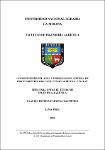Mostrar el registro sencillo del ítem
Uso eficiente del agua y energía en el sistema de riego presurizado caso: Fundo Agrícola - UNALM
| dc.contributor.advisor | Ascencios Templo, David Ricardo | |
| dc.contributor.advisor | Meza Capcha, Karem Belén | |
| dc.contributor.author | Molina Raymundo, Claudia Estefany | |
| dc.date.accessioned | 2022-03-15T22:03:51Z | |
| dc.date.available | 2022-03-15T22:03:51Z | |
| dc.date.issued | 2021 | |
| dc.identifier.uri | https://hdl.handle.net/20.500.12996/5268 | |
| dc.description | Universidad Nacional Agraria La Molina. Facultad de Ingeniería Agrícola. Departamento Académico de Recursos Hídricos | es_PE |
| dc.description.abstract | La presente investigación tuvo como objetivo diseñar y evaluar los escenarios para el uso eficiente del agua y energía en un sistema de riego presurizado, caso: Fundo agrícola en la Universidad Nacional Agraria La Molina, se diseñó diferentes sistemas de riego, se evaluó la eficiencia de riego, energía y se estimó los costos energéticos y emisiones de CO2, para compararlos posteriormente. Se realizó el balance hídrico, el diseño agronómico, coeficiente de uniformidad, y eficiencia de riego, se tomó en cuenta la sensibilidad del cultivo a las sales y la conductividad eléctrica del agua. Se planteó diferentes escenarios para una misma área y cultivo: caudal constante y altura dinámica total variable, caudal variable y altura dinámica total constante, caudal y altura dinámica total variable, caudal y altura dinámica total constante, y bombas en paralelo. Se calcularon los costos energéticos sin y con el variador de frecuencia. Se determinó la región de operación admitida y permitida y se calculó las emisiones de CO2 sin y con el variador de frecuencia para los diferentes escenarios. Se obtuvo como resultados que los altos valores de eficiencia energética no garantiza menores costos de energía, sin embargo el uso de variadores de frecuencia permitieron el ahorro de energía y reducción de emisiones para el primer escenario de 17.45 % ,segundo escenario de 29 % y tercer escenario de 29.30 % por año con respecto al no uso del variador de frecuencia, los variadores permiten la reducción de CO2 de todos los escenarios planteados y la recuperación de la inversión varía entre 5 a 8 años | es_PE |
| dc.description.abstract | The objective of this research was to design and evaluate the scenarios for the efficient use of water and energy in a pressurized irrigation system case: Fundo agrícola at the Universidad Agraria La Molina, different irrigation systems were designed, the efficiency of irrigation, energy and energy costs and CO2 emissions were estimated, to be compared later. The water balance, agronomic design, uniformity coefficient, and irrigation efficiency were carried out, taking into account the sensitivity of the crop to salts and the electrical conductivity of the water. Different scenarios were proposed for the same area and crop: constant flow and variable total dynamic head, variable flow and constant total dynamic head, variable total dynamic head and flow, constant total dynamic head and flow, and pumps in parallel. The energy costs were calculated without and with the frequency inverter. The permitted and permitted operating region was determined and the CO2 emissions were calculated without and with the frequency inverter for the different scenarios. The results were obtained that high energy efficiency values do not guarantee lower energy costs, however the use of frequency inverters allowed energy savings and emission reduction for the first scenario of 17.45 %, second scenario of 29 % and third. scenario of 29.30 % per year with respect to the non-use of the frequency variator, the variators allow the reduction of CO2 of all the scenarios proposed and the recovery of the investment varies between 5 to 8 years | en_US |
| dc.format | application/pdf | en_US |
| dc.language.iso | spa | es_PE |
| dc.publisher | Universidad Nacional Agraria La Molina | es_PE |
| dc.rights | info:eu-repo/semantics/openAccess | en_US |
| dc.rights.uri | https://creativecommons.org/licenses/by-nc/4.0/ | * |
| dc.subject | Riego presurizado | es_PE |
| dc.title | Uso eficiente del agua y energía en el sistema de riego presurizado caso: Fundo Agrícola - UNALM | es_PE |
| dc.type | info:eu-repo/semantics/bachelorThesis | en_US |
| thesis.degree.discipline | Ingeniería Agrícola | es_PE |
| thesis.degree.grantor | Universidad Nacional Agraria La Molina. Facultad de Ingeniería Agrícola | es_PE |
| thesis.degree.name | Ingeniero Agrícola | es_PE |
| dc.subject.ocde | https://purl.org/pe-repo/ocde/ford#4.01.06 | es_PE |
| renati.author.dni | 77331439 | es_PE |
| dc.publisher.country | PE | es_PE |
| dc.type.version | info:eu-repo/semantics/publishedVersion | en_US |
| renati.advisor.orcid | https://orcid.org/0000-0001-6161-5162 | es_PE |
| renati.advisor.orcid | https://orcid.org/0000-0002-4143-4388 | es_PE |
| renati.advisor.dni | 07935653 | es_PE |
| renati.advisor.dni | 47231787 | es_PE |
| renati.type | https://purl.org/pe-repo/renati/type#tesis | es_PE |
| renati.level | https://purl.org/pe-repo/renati/level#tituloProfesional | es_PE |
| renati.discipline | 811096 | es_PE |
| renati.juror | Rázuri Ramírez, Luis Ramón | |
| renati.juror | Goicochea Ríos, Javier Antonio | |
| renati.juror | Arapa Quispe, José Bernardino |
Ficheros en el ítem
Este ítem aparece en la(s) siguiente(s) colección(ones)
-
IAG-RH Tesis [307]



